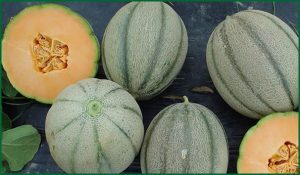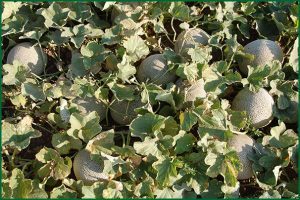
Image provided by Jonathan Schultheis, NC State University.
Melon (Cucumis melo L.) is a highly polymorphic cucurbit prized around the world for its sweet, juicy fruit that are consumed fresh. Melon fruits are harvested immature in many areas for use as a fresh or cooked vegetable. Melon fruit are commonly dried in the Central Asian countries of Turkmenistan and Uzbekistan. Fruit may also be processed for juice and flavoring, and melon seeds are a source of high-quality cooking oil and high protein seed meal.
Total melon production by ninety-seven countries was estimated at 44.4M tonnes in 2014 (FAOSTAT). Production ranged from 15 tonnes (Switzerland) to 14.8M tonnes (China). U.S. production was estimated at 787,030 tonnes in 2014.
Melons are important in local, national and international trade. In the U.S., melons are consumed fresh. California and Arizona dominate U.S. production for shipment throughout the country, but delicious melons are also produced in season in many parts of the country. Orange flesh cantaloupe and greenflesh honeydew are the predominant melon types grown. Limited arrays of “specialty” melons (e.g., Casaba, Santa Claus) can be found in many markets, while central Asian (short and long shelf life types) and Korean (‘Sprite’) types may be available seasonally in ethnic markets.
Industry stakeholders identified Powdery mildew, Cucumber mosaic virus (CMV), and Cucurbit yellow stunting disorder virus (CYSDV) virus as major disease threats to melon production. Though Downy mildew, Fusarium wilt, Gummy stem blight, and Phytophthora rot are considered priority diseases for growers of other cucurbits, these diseases are also of concern for melon growers.

Immature melon. Image provided by J. McCreight, USDA-ARS, CA
